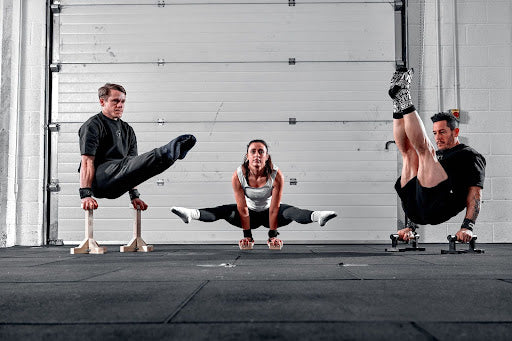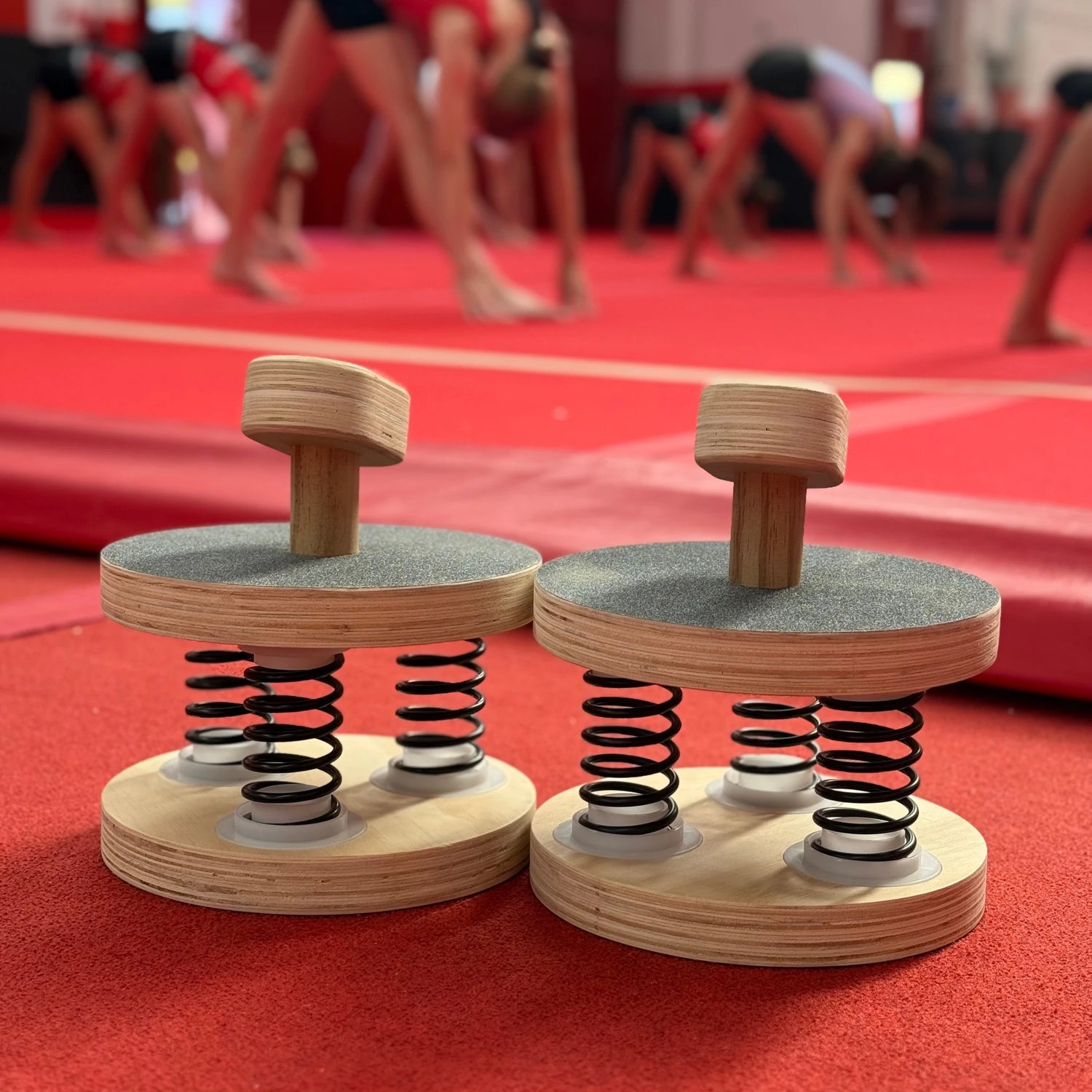
The Handstand Muscles Used and How to Build Them
|
|
Time to read 6 min

Check out our exciting new balance product launches. Developed and tested by...
|
|
Time to read 6 min
The handstand is more than just an impressive gymnastic feat; it's a great exercise that challenges and strengthens multiple muscle groups throughout the whole body.
From the shoulder muscles to the core muscles and even the little bones in your wrists, handstand work requires a combination of strength, body awareness, and proper form.
This article delves into the long list of handstand muscles engaged during a handstand and provides insights into the best ways to build handstand muscles, ensuring a safe and effective handstand journey.
Before diving into the techniques and exercises to build handstand muscles, it's essential to understand the different muscles and the different ways they play a pivotal role in executing a perfect handstand .
Shoulder Muscles: The main shoulder muscles involved are the deltoids, which bear the entire body weight during a handstand. They work in tandem with the shoulder girdle, comprising the clavicle and scapula, to provide shoulder stability.
Trapezius Muscle: Located in the upper back, the trapezius aids in elevating the shoulder blades and stabilizing the neck and head during the inverted position, making it one of the key handstand muscles.
Chest Muscles: The pectoralis major and minor help stabilize the shoulders and assist in maintaining balance.
Upper Back and Back Muscles: Handstand muscles like the erector spinae and back extensors maintain the alignment of the lumbar spine , preventing arching or collapsing.
Latissimus Dorsi: These large back muscles assist in keeping the arms close to the ears, ensuring a straight line from hands to toes.
Lower Back: Together with the abs, the lower back muscles provide stability and maintain the neutral position of the spine.
Hip Flexors and Inner Thigh Muscles: These muscles help in keeping the legs together and straight, contributing to the overall alignment.
While the legs don't bear weight in a handstand, the muscles in the lower body, especially the hip flexors and inner thigh muscles, play a role in maintaining proper alignment and balance and are a great way to strengthen your handstand.
Key takeaway? Handstand muscles are located all over the body - not just in our arms and shoulders!
Wrist Mobility and Strength: The wrists support the entire weight of the body. Ensuring flexibility and strength in the wrists prevents injuries.
Elbow Joint: Stability in the elbows is crucial to prevent bending, which can compromise balance.
Achieving a freestanding handstand is not just about balance; it's about having the necessary strength in the right places. Here's how to build handstand muscles for strength in the primary muscle groups involved.
Exercises:
Regular Push-Ups: A foundational exercise that strengthens nearly all handstand muscles, including the chest, shoulders, and triceps. Ensure that your hands are placed shoulder-width apart and maintain a straight line from head to heels.
Handstand Push-Ups: Once you're comfortable with wall-supported handstands, begin practicing handstand push-ups against the wall. This exercise targets the shoulders, triceps, and upper back.
Bench Press: Incorporating bench presses into your strength training routine can build chest and shoulder strength. Start with lighter weights to ensure proper form and prevent injuries.
Downward Dog Position: This yoga pose stretches the shoulders and hamstrings while building strength. Hold the position for 30 seconds to a minute, focusing on pushing through the shoulders.
Tips:
Overhead Shoulder Mobility: Ensure that you have a good range of motion in your shoulders. Incorporate shoulder stretches and mobility drills to prevent injuries.
Avoiding Shoulder Injury: Always warm up before exercises and avoid overtraining. If you experience pain, consult a physical therapist .
A strong core is vital for maintaining balance and alignment in a handstand and is arguably one of the most important handstand muscles used in the body.
Exercises:
Plank Position: Hold a plank for 1-2 minutes, ensuring that your body forms a straight line from head to heels. This strengthens the abdominal muscles and lower back.
Isometric Muscle Contraction: Exercises like the hollow body hold engage the entire core. Lie on your back, lift your legs and shoulders off the ground, and hold.
Leg Raises: While hanging from a bar, lift your legs to a 90-degree angle. This targets the lower abs and hip flexors.
Tips:
Maintain proper alignment during exercises to maximize benefits.
Consistency is key. Regular core workouts will significantly aid your handstand training.
While the legs don't bear weight during a handstand, strong legs contribute to overall body control and alignment.
Exercises:
Squats: Strengthen the quadriceps, hamstrings, and glutes.
Lunges: Enhance balance and leg strength.
Tips:
Focus on flexibility. Tight hamstrings or hip flexors can hinder your ability to achieve a straight line in a handstand.
Given that the wrists and elbows support the entire body weight , it's crucial to prepare them.
Exercises:
Wrist Curls: Using light weights, perform wrist curls to strengthen the forearm muscles.
Wrist Mobility Drills: Circular motions, flexions, and extensions can enhance flexibility.
Elbow Stability Exercises: Incorporate movements that strengthen the triceps and forearm muscles.
Tips:
Always warm up the wrists and elbows before handstand practice to increase blood flow and reduce the risk of injury.
With strength training underway and handstand muscles atrting to be developed, it's time to focus on specific handstand exercises and techniques.
How-To:
Start in a plank position with your feet against the wall.
Walk your feet up the wall as you move your hands closer to it.
Aim to get your hands as close to the wall as possible, maintaining a straight line .
Hold the position for as long as comfortable.
Benefits:
Enhances shoulder strength and stability.
Promotes body awareness and alignment.
Practicing handstand holds will help build endurance and balance alongside the key handstand muscles.
How-To:
Begin with wall-supported holds and gradually progress to freestanding handstands .
Focus on engaging the core and maintaining a neutral spine.
A dynamic movement that builds explosive strength and supports in developing handstand muscles.
How-To:
From a handstand position against the wall, lower yourself until your head touches the ground.
Use your legs to generate momentum and push back up.
Caution:
Ensure you've built adequate shoulder and core strength before attempting.
Avoid if you have any shoulder injuries.
A more advanced movement that requires significant strength.
How-To:
From a handstand position, lower yourself in a controlled manner until your head touches the ground.
Push back up using only your upper body strength.
Benefits:
Builds immense upper body strength and shoulder stability.
Once comfortable with holds, practice walking on your hands.
Tips:
Start with small steps.
Use a spotter or soft surface to prevent injuries.
While the primary focus is on building handstand muscles and achieving the handstand, there are numerous other benefits.
Being upside down promotes increased blood flow to the upper body and head. This can enhance the function of the pituitary gland and improve overall blood circulation.
Supporting your entire body weight can increase bone density, promoting better bone health.
The inverted position can have calming effects, reducing the production of the stress hormone cortisol. It also enhances body awareness and focus.
Even seasoned practitioners can make errors. Here are some common mistakes and tips to rectify them. Many of these issues will be resolved by strengthening the handstand muscles covered in this article.
Often due to weak core muscles or tight hip flexors.
Solution:
Strengthen the core and focus on keeping the ribs tucked in.
Stretch the hip flexors regularly.
Failing to push through the shoulders can lead to instability.
Solution:
Always engage the shoulder blades by pushing away from the ground.
Incorporate shoulder strengthening exercises.
Placing hands incorrectly can strain the wrists.
Solution:
Place hands shoulder-width apart.
Ensure fingers are spread out to distribute weight.
Trying advanced moves without adequate preparation.
Solution:
Remember, achieving a perfect handstand takes a long time and lots of practice .
Progress gradually, ensuring mastery at each stage.
If you're serious about mastering the handstand and would like some further guidance to build your handstand muscles, consider consulting with professionals.
Physical Therapist: Can provide insights into muscle imbalances, flexibility issues, and prevent potential injuries.
Handstand Practitioner or Coach: Offers guidance on technique, progression, and personalized training plans.
We know some fantastic online handstand coaches, by all means drop us an email or DM on social media and we’ll put you in touch!
The development of handstand muscles is a testament to hard work, dedication, and mastery over one's body with good balance. By understanding the muscle groups involved and systematically building strength, flexibility, and balance, you can elevate your handstand skills to the next level.
Remember, it's not just about strength of the handstand muscles but also body control, proper form, and body awareness . Embrace the journey, stay consistent, and soon, you'll be holding a freestanding handstand with confidence and grace.
Be sure to drop us a message on social and let us know how you're progressing with the development of your training and handstand muscles!




